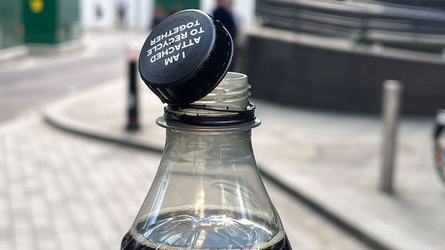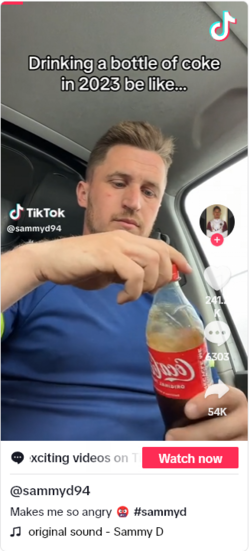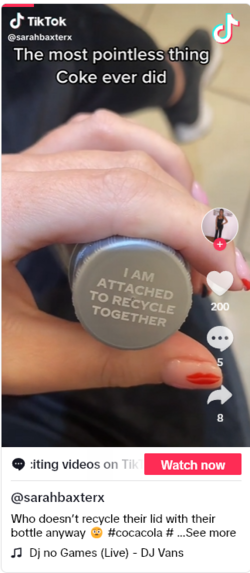By Katie Deighton
May 16, 2024 6:00 am ET

The bottle top says, ‘I am attached to recycle together.’ Some soda drinkers appreciate Coke’s environmental effort and like that the cap can’t get lost. PHOTO: GEORGE DOWNS/THE WALL STREET JOURNAL
Coca-Cola’s new sustainable bottle caps are smacking into a sensitive area: soda drinkers’ faces.
In 2021, the beverage giant introduced a design that connected some of its plastic bottles to their caps as a test in Germany and Spain and subsequently expanded it to other European markets. The change helps more caps get recycled with their bottles rather than thrown in the trash or on the ground, the company said. It also complies with a European Union directive set to take effect this summer, which has pushed Coke’s rivals to follow suit.
EU officials may be pleased, but soda drinkers are another story. Connected bottle caps hit and scratch their noses, cheeks and lips as they drink, and can be more difficult to close completely, some consumers say.

TikTok (Archive)
“You literally have a fight with your bottle now every time you take a drink,” said Benny James, a podcast host and social media influencer from south London. “It’s just irritating,” he said, adding that he now prefers to buy soda in cans.
The change highlights the often-chasmic gap between what humans, marketing departments and environmentalists consider optimal packaging. Sustainably-minded design sometimes makes for packaging that’s easier to open and use. But not always.
When Nature Valley in 2021 introduced recyclable wrappers on its Crunch granola bars, customers complained the packaging was too hard to open. Reusable fast-food containers have received blowback from some restaurants whose tests found them expensive to roll out as well as inconvenient for consumers and staff.
In this case, Coke and its competitors weren’t given a choice.
Coca-Cola, PepsiCo, Danone and Nestlé had argued against the EU’s idea to require attached caps on many plastic bottles, and asked for the chance to prove the efficacy of their preferred strategies to cut plastic waste.
Soft drinks trade association Unesda and the European Federation of Bottled Waters said the mandate could result in up to 200,000 tons of additional plastic being used a year and cost companies as much as 8.7 billion euros, or $9.4 billion, to adapt bottling lines, citing commissioned research. Tethered caps had also not been proven to safely transport liquids, particularly carbonated ones, they said.
EU commissioners pushed ahead with the new rule, however, and drinks companies moved to comply. Coke began talking up the environmental benefits. But its early experience has raised some new issues.
Coke drinkers are discussing their disgruntlement and hacks—including the use of brute force to rip off the top and reclaim the old soda-drinking experience. TikTok videos have parodied the face-bumping design and the way drinkers spin the top to achieve optimum mouth-grasp.

TikTok (Archive)
Some consumers are confused. Changing, uneven and conflicting recycling rules have left some Europeans under the impression that plastic bottle tops cannot be recycled alongside their bottles, and must be thrown away. Coke has tried to make the situation clear by printing messages like “I am attached to recycle together” on its tethered caps, but the message isn’t always getting through.
“It took me a few bottles to realize it was actually meant to stay on,” said Chelsea Salt, a Coke Zero fan from Grimsby, U.K., who made one of the TikTok skits. “I kept trying to rip them off.”
Attached caps do have their defenders.
“I love them, they come with less admin” when it comes to recycling, said Sophie Beecroft, a London-based Diet Coke drinker. Other consumers say the tether alleviates cap-losing anxiety.
In emailed responses, Coca-Cola said its consumer tests found people were generally supportive of the new design, especially once they understood the recycling imperative behind it. The company said it has no evidence the new bottle caps have significantly affected sales one way or another. In 2023, Coca-Cola’s global sales of its array of beverages grew 6% from the year prior to $45.8 billion.
“We have been pleased by the response from many consumers who appreciate the steps we are taking to improve circularity in our packaging and prevent litter,” Coca-Cola said. “We recognize that it takes getting used to this change.”
European Commission spokesman Adalbert Jahnz noted that the particulars of complying with the attached-caps regulation were up to beverage companies. “EU law does not impose a specific design, and naturally some will be more successful than others,” he said.
There are other designs that would satisfy the European mandate.
Swiss mold-maker Büsser Formenbau designed the EasyCap, a top with a tether that can be extended so that the cap is held out of the way when a consumer is drinking. Another Swiss company, Corvaglia, offers a “shift cap,” which locks in place against the neck of the bottle in order to avoid hitting drinkers’ faces.
California-based water brand Crystal Geyser uses an “EZ-Open” cap that flips back and clicks into place on some of its bottles. But typical screw caps still reign supreme in the U.S., where lawmakers haven’t mandated attached caps. Politicians in California and Maine tried to, but got little support.
Coca-Cola said it would continue to assess whether to take its tethered bottle design to markets outside Europe as well as look into new packaging designs.
“If we found an even better way to do that without compromising the current user experience,” the Coke spokesman said, “we would look into it.”
Source (Archive)
May 16, 2024 6:00 am ET

The bottle top says, ‘I am attached to recycle together.’ Some soda drinkers appreciate Coke’s environmental effort and like that the cap can’t get lost. PHOTO: GEORGE DOWNS/THE WALL STREET JOURNAL
Coca-Cola’s new sustainable bottle caps are smacking into a sensitive area: soda drinkers’ faces.
In 2021, the beverage giant introduced a design that connected some of its plastic bottles to their caps as a test in Germany and Spain and subsequently expanded it to other European markets. The change helps more caps get recycled with their bottles rather than thrown in the trash or on the ground, the company said. It also complies with a European Union directive set to take effect this summer, which has pushed Coke’s rivals to follow suit.
EU officials may be pleased, but soda drinkers are another story. Connected bottle caps hit and scratch their noses, cheeks and lips as they drink, and can be more difficult to close completely, some consumers say.

“You literally have a fight with your bottle now every time you take a drink,” said Benny James, a podcast host and social media influencer from south London. “It’s just irritating,” he said, adding that he now prefers to buy soda in cans.
The change highlights the often-chasmic gap between what humans, marketing departments and environmentalists consider optimal packaging. Sustainably-minded design sometimes makes for packaging that’s easier to open and use. But not always.
When Nature Valley in 2021 introduced recyclable wrappers on its Crunch granola bars, customers complained the packaging was too hard to open. Reusable fast-food containers have received blowback from some restaurants whose tests found them expensive to roll out as well as inconvenient for consumers and staff.
In this case, Coke and its competitors weren’t given a choice.
Coca-Cola, PepsiCo, Danone and Nestlé had argued against the EU’s idea to require attached caps on many plastic bottles, and asked for the chance to prove the efficacy of their preferred strategies to cut plastic waste.
Soft drinks trade association Unesda and the European Federation of Bottled Waters said the mandate could result in up to 200,000 tons of additional plastic being used a year and cost companies as much as 8.7 billion euros, or $9.4 billion, to adapt bottling lines, citing commissioned research. Tethered caps had also not been proven to safely transport liquids, particularly carbonated ones, they said.
EU commissioners pushed ahead with the new rule, however, and drinks companies moved to comply. Coke began talking up the environmental benefits. But its early experience has raised some new issues.
Coke drinkers are discussing their disgruntlement and hacks—including the use of brute force to rip off the top and reclaim the old soda-drinking experience. TikTok videos have parodied the face-bumping design and the way drinkers spin the top to achieve optimum mouth-grasp.

Some consumers are confused. Changing, uneven and conflicting recycling rules have left some Europeans under the impression that plastic bottle tops cannot be recycled alongside their bottles, and must be thrown away. Coke has tried to make the situation clear by printing messages like “I am attached to recycle together” on its tethered caps, but the message isn’t always getting through.
“It took me a few bottles to realize it was actually meant to stay on,” said Chelsea Salt, a Coke Zero fan from Grimsby, U.K., who made one of the TikTok skits. “I kept trying to rip them off.”
Attached caps do have their defenders.
“I love them, they come with less admin” when it comes to recycling, said Sophie Beecroft, a London-based Diet Coke drinker. Other consumers say the tether alleviates cap-losing anxiety.
In emailed responses, Coca-Cola said its consumer tests found people were generally supportive of the new design, especially once they understood the recycling imperative behind it. The company said it has no evidence the new bottle caps have significantly affected sales one way or another. In 2023, Coca-Cola’s global sales of its array of beverages grew 6% from the year prior to $45.8 billion.
“We have been pleased by the response from many consumers who appreciate the steps we are taking to improve circularity in our packaging and prevent litter,” Coca-Cola said. “We recognize that it takes getting used to this change.”
European Commission spokesman Adalbert Jahnz noted that the particulars of complying with the attached-caps regulation were up to beverage companies. “EU law does not impose a specific design, and naturally some will be more successful than others,” he said.
There are other designs that would satisfy the European mandate.
Swiss mold-maker Büsser Formenbau designed the EasyCap, a top with a tether that can be extended so that the cap is held out of the way when a consumer is drinking. Another Swiss company, Corvaglia, offers a “shift cap,” which locks in place against the neck of the bottle in order to avoid hitting drinkers’ faces.
California-based water brand Crystal Geyser uses an “EZ-Open” cap that flips back and clicks into place on some of its bottles. But typical screw caps still reign supreme in the U.S., where lawmakers haven’t mandated attached caps. Politicians in California and Maine tried to, but got little support.
Coca-Cola said it would continue to assess whether to take its tethered bottle design to markets outside Europe as well as look into new packaging designs.
“If we found an even better way to do that without compromising the current user experience,” the Coke spokesman said, “we would look into it.”
Source (Archive)